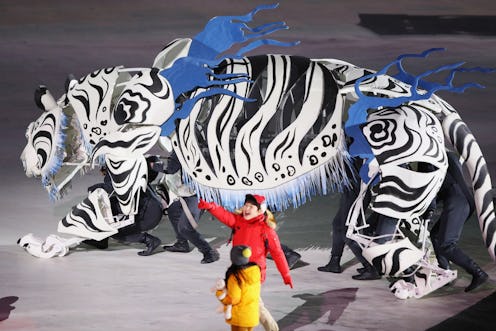News
Here's Why You Keep Seeing A White Tiger At The Olympics

Putting on the Olympic Games gives the host country a chance to embrace and exhibit myriad aspects of its culture and history, and it's already clear that the Korean organizers of the PyeongChang Olympics are not breaking with that pattern. In fact, the Olympic mascot is a white tiger precisely because the animal is very symbolic in South Korean culture.
The tiger's name is Soohorang, and the symbolism starts right there. The word "sooho" means "protection" in Korean, so Soohorang is meant to stand as protection for all of the athletes, fans, and officials who have gathered in PyeongChang for the games. "Rang," then, has a double meaning. It's the middle letter of the Korean word for "tiger," which is "ho-rang-i,” and it's also the final letter in “Jeong-seon A-ri-rang,” which is an important and well-loved folk song from the province in PyeongChang's Gangwon Province.
Beyond that, though, the tiger is generally considered to be the Republic of Korea's guardian animal, and it's a familiar, benevolent figure in Korean folklore and mythology. The white tiger is even considered to be a sacred creature, so having a tiger mascot for any Olympics held in Korea is a very meaningful choice.
And, in fact, this isn't the first time that a Korean Olympic Games has featured a striped feline mascot. The 1988 Seoul Olympics also had a tiger as a mascot, though Hodori was an orange tiger rather than a white one. Hodori also got his name from the Korean word for tiger — "Ho" is the first letter in the Korean word "ho-rang-i." The "dori" part of his name, though, is simply a common way of denoting a male name.
Even before the beginning of the 2018 Winter Games, Soohorang had already become quite popular both at home and around the world. He had a cameo at the 2016 Rio De Janeiro Summer Games, and he's been putting in some serious miles traversing his home country in the lead-up to the Winter Olympics.
"It's a beautiful animal, strongly associated with Korean culture," said Gunilla Lindberg, chair of the IOC Coordination Commission for the 2018 Winter Olympic Games, referring to the white tiger generally and Soohorang specifically. "It also symbolizes the close link between the Olympic Winter Games and the natural environment. I'm sure the new mascot will be very popular with Koreans and people around the world."
So far, Lindberg's prediction about Soohorang's popularity already seems to be coming true — especially after members of K-pop band BTS posed for selfies with him.
Soohorang, like most Olympic mascots, isn't alone — he's got Bandabi, the black Asian bear mascot of the 2018 Paralympic Games, right by his side for most of the events that he does. “The mascots have been designed to embody the collective will of everyone for the successful hosting of the Olympic and Paralympic Games in 2018, and experts of various fields contributed in the process,” said Lee Hee-beom, president of the PyeongChang 2018 organizing committee.
The mascots' first job, he said, would be to get the marketing and communications effort started and to get people around the world excited for the games — which appears to have succeeded.
While Time reports that you don't have much of a chance of seeing an actual tiger, white or otherwise, in the heavily populated and industrialized nation of South Korea, there are still some in the wild in North Korea. But even so, the tiger's symbolic position in the Korean peninsula has not at all diminished — and Soohorang's presence at so many of the Olympic events will only serve to strengthen it.